5 Bodyweight Exercises That Build More Strength Than Gym Workouts After 50
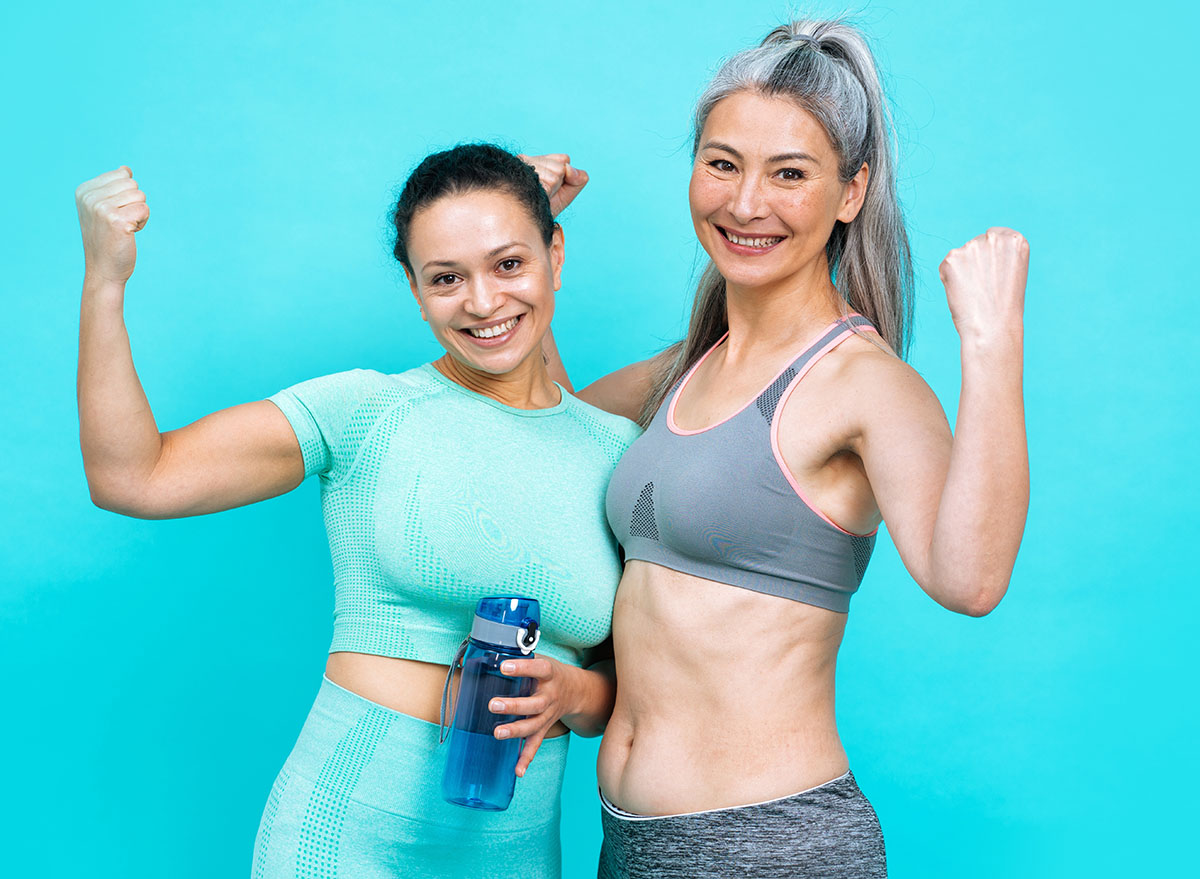
If you’ve noticed it’s harder to get up from the floor, struggle with grocery bags, or feel less stable on your feet, you might think it’s just part of getting older. The good news? Getting stronger is 100% possible for older adults and is actually incredibly important to health and longevity.
I’ve been a personal trainer for over 35 years and have been working in fitness for 40. I run a fitness education company that has trained hundreds of thousands of fitness professionals, so we have a huge amount of data when it comes to efficient training. Many people think that once they get into their fifties, they are on the decline, that they won’t be able to get stronger, so they should just focus on cardio fitness (or worse, not exercise at all).
Here’s exactly how to build real strength after 50 without ever setting foot in a gym.
The Challenges You’ll Face (And How to Overcome Them)

The biggest challenge is mental – people wait way too long to start because they think that strength training isn’t for them, and they convince themselves that they are fine as they get weaker. Struggling with grocery bags, finding it harder to get up from the floor, feeling less stable on their feet – they try to tell themselves it’s just part of getting older. By the time they decide to do something about it, they’ve lost years of strength that could have been maintained.
Recovery takes longer than it used to. When we’re in our 20s or 30s, we can train hard and bounce back quickly. After 50, our muscles need more time to repair and adapt. Push too hard without adequate rest, and we can end up sore for days or risk injury. Push too little and we won’t build strength. Finding that balance is tricky.
Joint issues start to become a problem. They have decades of wear and tear, and many people have some level of arthritis, old injuries that keep flaring up, or the joints simply don’t move as smoothly as they used to. Traditional gym exercises can put a heavy load on these joints, and once they cause pain, it can make people give up completely.
Older adults tend to take a confidence hit, too. Walking into a gym that’s full of younger people moving heavy weights is intimidating. A lot of people over 50 feel like it’s too late to start or that strength training isn’t for them anymore. They worry about looking silly or about hurting themselves.
There’s also a lot of conflicting information out there. Some sources say you need heavy weights to build strength. Others warn that weights are dangerous after 50. Some promote fancy equipment while others swear by specific programs. This confusion often leads to paralysis—people don’t know where to start, so they don’t start at all.
Why Bodyweight Exercises Work Better for You

Bodyweight exercises are brilliant for letting you work within your current capabilities without risking joint damage/pain by loading them with additional weight. When we do a push-up, our bodies naturally adjust the load based on the position and strength level. It’s impossible to make the mistake of piling too much weight on a bar and getting injured on the first rep.
They’re functional in a way that machine exercises aren’t. When you do a squat with your bodyweight, you’re training the exact movement pattern you use dozens of times every day – sitting down and standing up. When you do a leg press machine, you’re lying on your back pushing weight away from you, which bears no resemblance to any real-world movement.
Bodyweight training builds stability and balance at the same time as strength. Every bodyweight exercise requires you to control your own body in space, which activates all those small stabilising muscles that machines don’t touch. This is why people who train with bodyweight movements tend to move better in daily life than people who only use machines.
There’s no barrier to entry. You don’t need a gym membership, special equipment, or even much space. You can start today, right now, in your living room. This removes all the excuses and makes consistency much easier to achieve.
The movements are easier to modify. Can’t do a full push-up? Do them against a wall or a kitchen counter. Can’t do a full squat? Hold onto something for support. With gym equipment, modifications are often impossible or require different machines entirely.
You learn to control your own body, which is the most important type of strength as we age. Being able to get up from the floor, climb stairs, or catch yourself when you trip all require bodyweight control. No amount of time on a leg press machine will teach you these skills.
5 Bodyweight Exercises That Build Strength at Home After 50
Exercise 1: Wall Push-Ups (progressing to counter push-ups, then floor push-ups)
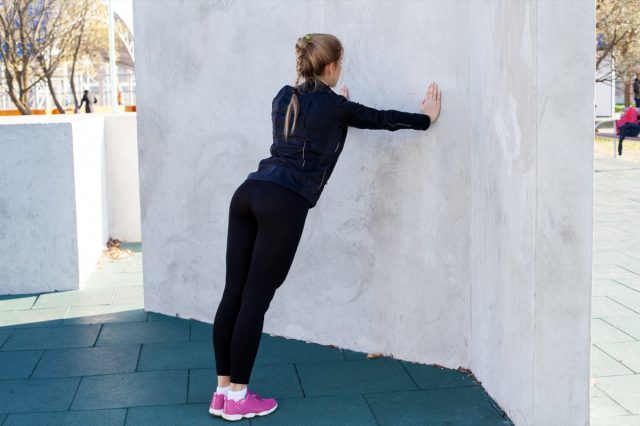
Why it works: This movement builds your chest, shoulders, and triceps while teaching you to control your body as a single unit. It’s also completely scalable – you can make it easier or harder by changing the angle of your body. The pushing strength you build here translates directly to getting up from the floor or pushing yourself up from a chair.
How to do it:
- Stand about arm’s length from a wall
- Place your hands flat against the wall at shoulder height and slightly wider than your shoulders
- Keep your body in a straight line from head to heels – don’t let your hips sag or stick out
- Bend your elbows to bring your chest towards the wall, keeping your elbows at about a 45-degree angle to your body (not flared straight out to the sides)
- Push back to the starting position
- That’s one rep
Common mistakes: The biggest one is letting your hips move separately from the rest of your body. Your whole body should move as one unit. Another mistake is standing too close to the wall, which makes the exercise too easy to build strength. You should feel like you’re working. Also, watch that you’re not shrugging your shoulders up towards your ears—keep them down and back.
Exercise 2: Sit-to-Stand (progressing to bodyweight squats)

Why it works: This is the most functional exercise there is because it’s literally the movement you do every time you sit down or stand up. It builds strength in your quads, glutes, and core. Strong legs are the single biggest factor in maintaining independence as we age.
How to do it:
- Start by sitting in a sturdy chair without using your hands
- Stand up without leaning forward excessively or using momentum
- Lower yourself back down with control – don’t just drop into the seat
- If this is too easy, use a lower chair or progress to hovering just above the seat before standing back up
- Eventually, you can do this without a chair at all (that’s a squat)
Common mistakes: Using your hands to push off is the most common cheat. If you need to use your hands, that’s fine for now, but work towards doing it without them. Another mistake is shooting your knees forward as you stand—instead, think about pushing your hips back slightly as you sit down and driving through your heels as you stand up. Also, don’t hold your breath—breathe out as you stand up.
Exercise 3: Heel Raises

Why it works: Your calves are critical for walking, balance, and preventing falls. They’re often neglected in training programs, but weak calves can make you unstable and increase your risk of ankle injuries. This exercise also helps maintain the ankle mobility you need to walk properly.
How to do it:
- Stand with your feet hip-width apart, holding onto a counter or wall for light support if needed
- Rise up onto the balls of your feet, lifting your heels as high as you can
- Hold for a second at the top
- Lower back down with control – don’t just drop down
- The lowering phase is just as important as the raising phase
Common mistakes: Rushing through the movement and bouncing at the bottom. This should be controlled and deliberate. Another mistake is leaning forward or backward—stay upright. Also, many people roll onto the outside or inside of their feet – keep the weight evenly distributed across the ball of your foot.
Exercise 4: Assisted Step-Ups
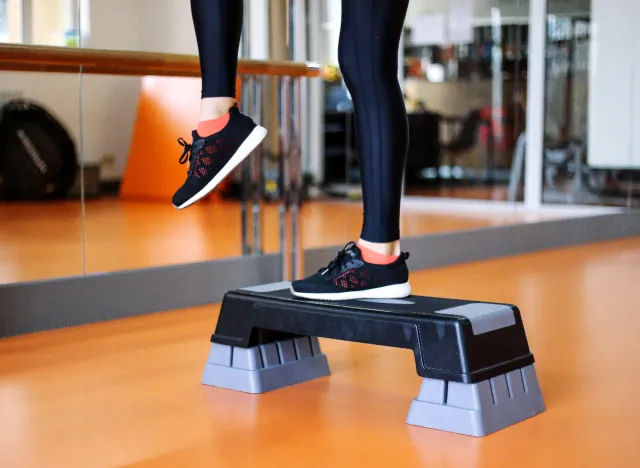
Why it works: This exercise builds single-leg strength, which is crucial because most of life happens on one leg at a time (walking, climbing stairs, stepping over obstacles). It also challenges your balance and coordination in a safe, controlled way.
How to do it:
- Find a step or sturdy platform about 6-8 inches high (the bottom step of your stairs works well)
- Step up with one foot, pushing through that heel to lift your body up
- Bring your other foot up to meet it
- Step back down with the same leg that went up first, then bring the other foot down
- Do all your reps on one leg before switching
- Hold onto a railing or wall for balance if needed
Common mistakes: Pushing off with the bottom foot instead of truly lifting yourself with the top leg. The leg on the step should do all the work. Another mistake is leaning too far forward—stay upright. Also, don’t use momentum by bouncing or swinging your leg up. Keep the movement controlled.
Exercise 5: Dead Bug

Why it works: Your core strength determines how well you move and how stable you are during every other exercise and daily activity. This exercise teaches you to keep your core engaged while moving your limbs independently, which is a skill most people lose as they age. A strong core also protects your lower back.
How to do it:
- Lie on your back with your arms extended straight up towards the ceiling
- Lift your legs so your knees are bent at 90 degrees and your shins are parallel to the floor
- Press your lower back into the floor – there should be no arch under your back
- Slowly extend your right arm overhead while straightening your left leg, hovering it a few inches off the floor
- Return to the starting position and repeat on the opposite side
- That’s one rep
Common mistakes: The most common is letting your lower back arch off the floor as you extend your limbs. If this happens, you’re not engaging your core properly. Reduce the range of motion until you can keep your back flat. Another mistake is holding your breath – breathe steadily throughout. Also, moving too quickly defeats the purpose—this should be slow and controlled.
Your Weekly Training Schedule
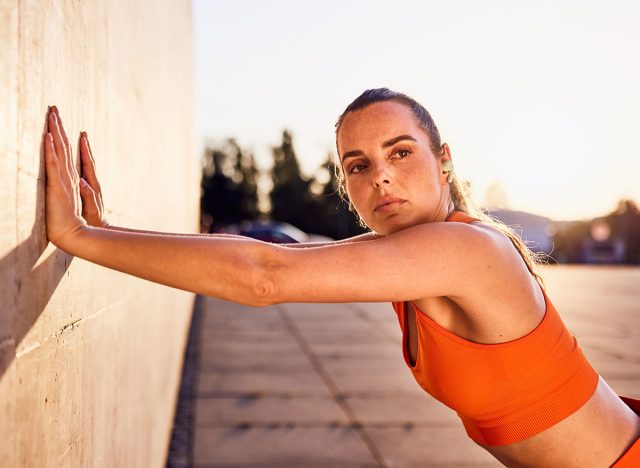
Start with three sessions per week with at least one rest day between sessions. Your muscles need time to recover and adapt, especially when you’re over 50. Monday, Wednesday, and Friday work well for most people.
For each exercise, begin with 2 sets of 8-10 reps. This might not sound like much, but remember, we’re building a foundation here. It’s better to start conservatively and progress steadily than to do too much too soon and end up too sore to continue.
After two weeks at this level, if you’re recovering well and the exercises feel manageable, add a third set. After another two weeks, you can start increasing the reps – aim for 12-15 reps per set.
Once you can comfortably do 3 sets of 15 reps for an exercise, it’s time to make it harder. For push-ups, move to a lower surface. For sit-to-stands, use a lower chair or eliminate the chair entirely. For heel raises, try doing them on one leg. For step-ups, use a higher step. For dead bugs, extend your limbs further or hold them in the extended position longer.
Listen to your body. If you’re still quite sore two days after a session, you might need an extra rest day that week. If you’re not feeling any challenge at all, you can add a fourth session per week, but I’d recommend making the exercises harder first before adding more frequency.
The key is consistency. Three moderate sessions per week that you actually do will beat five intense sessions that you quit after two weeks every single time.
What You Can Expect in 6-8 Weeks
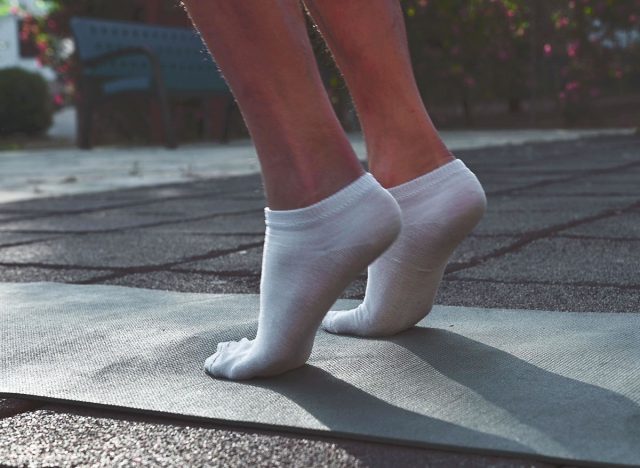
In the first two weeks, you’ll likely feel more sore than strong. This is normal. Your muscles are adapting to being challenged again. By week three, the soreness should decrease noticeably and you’ll start to feel more capable during the exercises themselves.
By week four to five, you’ll notice functional improvements in daily life. Getting up from chairs will feel easier. Climbing stairs won’t leave you as breathless. You might notice you’re more stable on your feet or that you can carry shopping bags without as much strain.
After 6-8 weeks of consistent training, you should see measurable progress in the exercises themselves. Movements that felt challenging at the start will feel much more manageable. You’ll likely have progressed to harder variations of several exercises. Your posture will probably improve – people often tell me they feel taller and more upright after a couple of months of training.
You won’t necessarily see dramatic visual changes in 6-8 weeks – building visible muscle takes longer, especially after 50. But you will feel stronger, more capable, and more confident in your body. Many people report sleeping better and having more energy throughout the day.
Your balance will likely improve noticeably. You’ll feel more secure when walking on uneven surfaces or turning quickly. Getting up from the floor or reaching for something on a high shelf will feel less precarious.
If you’re consistent with all three weekly sessions and gradually progress the difficulty, you should be able to do significantly more reps or harder variations of each exercise than when you started. For example, if you started with wall push-ups, you might be doing counter push-ups by week eight. If you started with sit-to-stands using your hands, you might be doing them hands-free or even starting to do proper squats.
The most important result isn’t something you can measure with numbers; it’s the confidence that comes from knowing your body is getting stronger, not weaker, as you age.